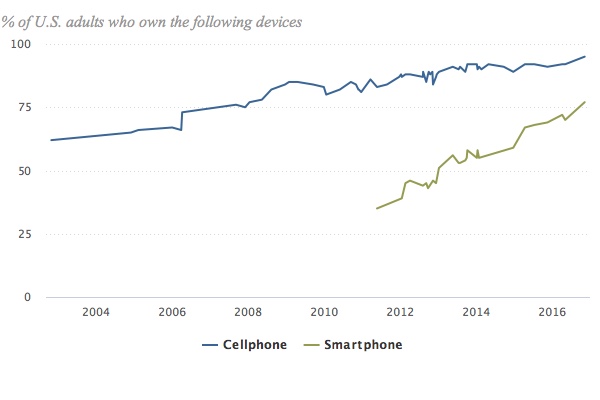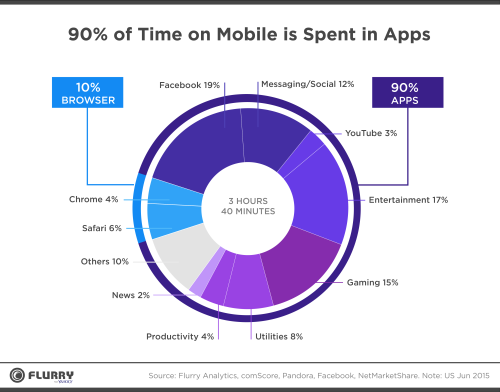The Case for Mobile
Organizations have gotten smart. They realize if they want to reach and engage their customer base, they are going to have to go mobile. Pew Research recently reported that smartphone use among Americans is up to a staggering 77 percent. That may not seem surprising until you realize how much that number has grown since 2011. Six years ago, only 35 percent of Americans owned smartphones.

And which demographic ranks at the top of ownership? Americans between the ages of 18 and 29 years old, 92 percent of them, in fact. If you’re a higher learning institution, that number should perk your ears.
Not only are your students using their smartphones, but more than half of them are using other mobile devices such as tablets. Taking this a bit further, we don’t have to assume what people are doing on their mobile devices. A 2015 report found people are spending 90 percent of their mobile time in apps – and only 10 percent in their browser. This report was released two years ago so it is highly likely the gap between those numbers has widened even further.

Not All Mobile Is Created Equal
Higher learning institutions are rolling out mobile apps in hopes of capturing their student’s attention, giving them greater access and functionality on the go, and responding to the increasing demand for a mobile presence. How many of them are succeeding is unknown. Mobile app success is highly subjective. Many institutions may think simply by having a mobile app, they have succeeded. But if the users were asked about their mobile experience, would they agree?
Related: Why Having a Mobile App for College Students Isn’t Enough
Nearly a quarter of all mobile apps are abandoned after one use and 62 percent will use an app less than 11 times. Of course, these statistics are for the general public but they highlight the fact that mobile app users are impatient and demanding – in a good way. They are pushing developers to do better, to think differently and to design apps people actually want to use.
Students may not have much of a say in how their school’s design their apps, but they should. Higher learning institutions who want to do more than slap an app onto a mobile device and call it a day are going to be the ones with higher student engagement, greater student outcomes and happier students. Mobile apps may not be the cure-all, but a well-designed, student-focused app will empower students to do more for themselves, take ownership of their educational journey, complete more tasks on time in less time, and reach their goals much easier.
Related: Case Study: How Lone Star College is providing students with the positive mobile experience they demand
Mobile Isn’t Desktop
The first thing schools need to understand is that the mobile device, particularly a smartphone, is vastly different from its desktop counterpart. What works for the desktop often will not work on a smartphone. You may have the best online portal in the country but that portal may not translate into an awesome mobile app unless you are intentional.
A responsive design means modifications must be made across different platforms so there is a seamless user experience. This isn’t always easy and requires an expert hand.
Smaller screens mean less space for the user and the developer. The viewer can see less information at once from their smartphone, impacting images, fonts, scrolling and content. Smartphones are also slower to process information than a desktop processor, taking more time to render images or load content.
How users interact with the app will differ as well. Users will tap on links instead of clicking or hovering and there is much less precision. Keyboard entry can be tricky as letters and fields for input are much smaller. These are just a few design issues developers must consider when designing an app.
Convenience, above All Else
A list of to dos and don’ts are easy to find but user behavior is what should drive the mobile design. What do users universally want? No matter who you ask, speed and ease of use will be the top user desires, plain and simple.
Students are no different and may even be more inclined to demand such features. They were raised on technology and live in an instant gratification world. To boil it down to one word, they expect their mobile experience will be convenient. How does Google define “convenient?” “Fitting in well with a person’s needs, activities and plans. Involving little trouble or effort. Situated so as to allow easy access to. Occurring in a place or at a time that is useful.” Does your app do that?
Convenience means apps are easy to access, easy to use and fast in their response. Students want to find information, complete a task and connect with friends while they’re standing in line at a coffee shop. They may only have seconds to engage with the app and they aren’t going to love an app where they have to wait or come back to when they have more time.
As much as higher learning institutions may consider mobile app design, students don’t want to even think about the design – they just expect the app to work how they want, when they want. They may only think about the design when they recognize the app isn’t meeting their needs.
Mobile Design Takes A Village
Higher learning institutions are not generally experts in designing user-friendly mobile apps. Most prefer to focus on the business of educating and managing the hundreds of other responsibilities required to keep the institution humming. Finding a technology partner can be a critical step towards making mobile a reality and ensuring they can provide users with the best possible mobile experience both now and as technology evolves.
One of the most important things a developer (inside the institution or a third party) can do is to know their audience. Asking basic questions will lay the foundation to design: Who is going to be using the app? How will they be using it? When will they be using it? Where will they be using it? Any developer or software provider should put the user front and center before designing or selling any mobile app. This means actually speaking to the users. Assuming, guessing or throwing darts at what is thought to be a need or requirement is no substitute for real focus groups.
Enlisting the help of the user to inform decisions and guide the design is perhaps the single best tactic in developing a mobile app that will do what it was intended to do. Going mobile is a sizable investment of time and resources. Why go at it half-heartedly? If you’re going to invest in mobile, do it right. Partner with experienced providers who can deliver an app that will not only be used but hailed as a key element for student success.




